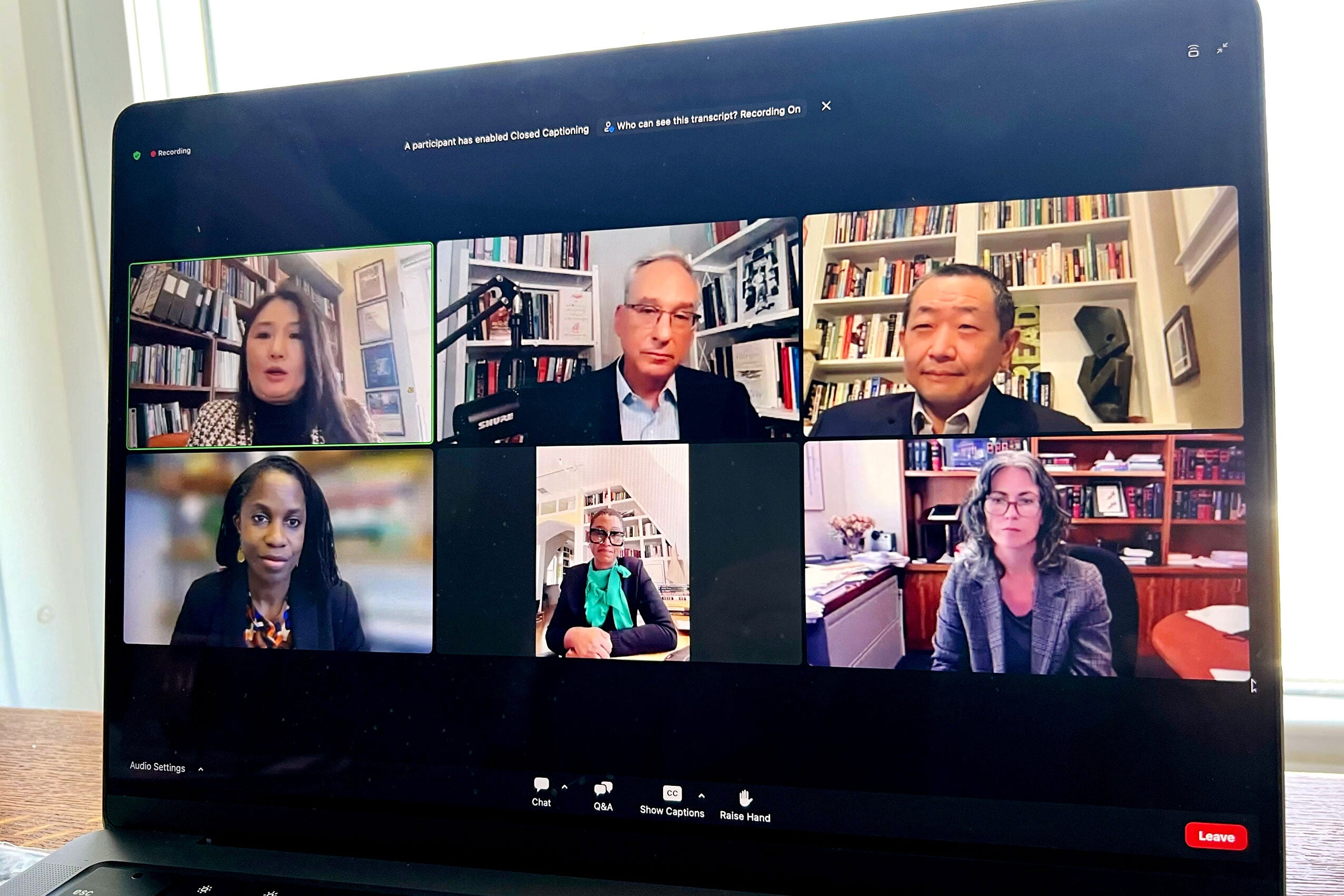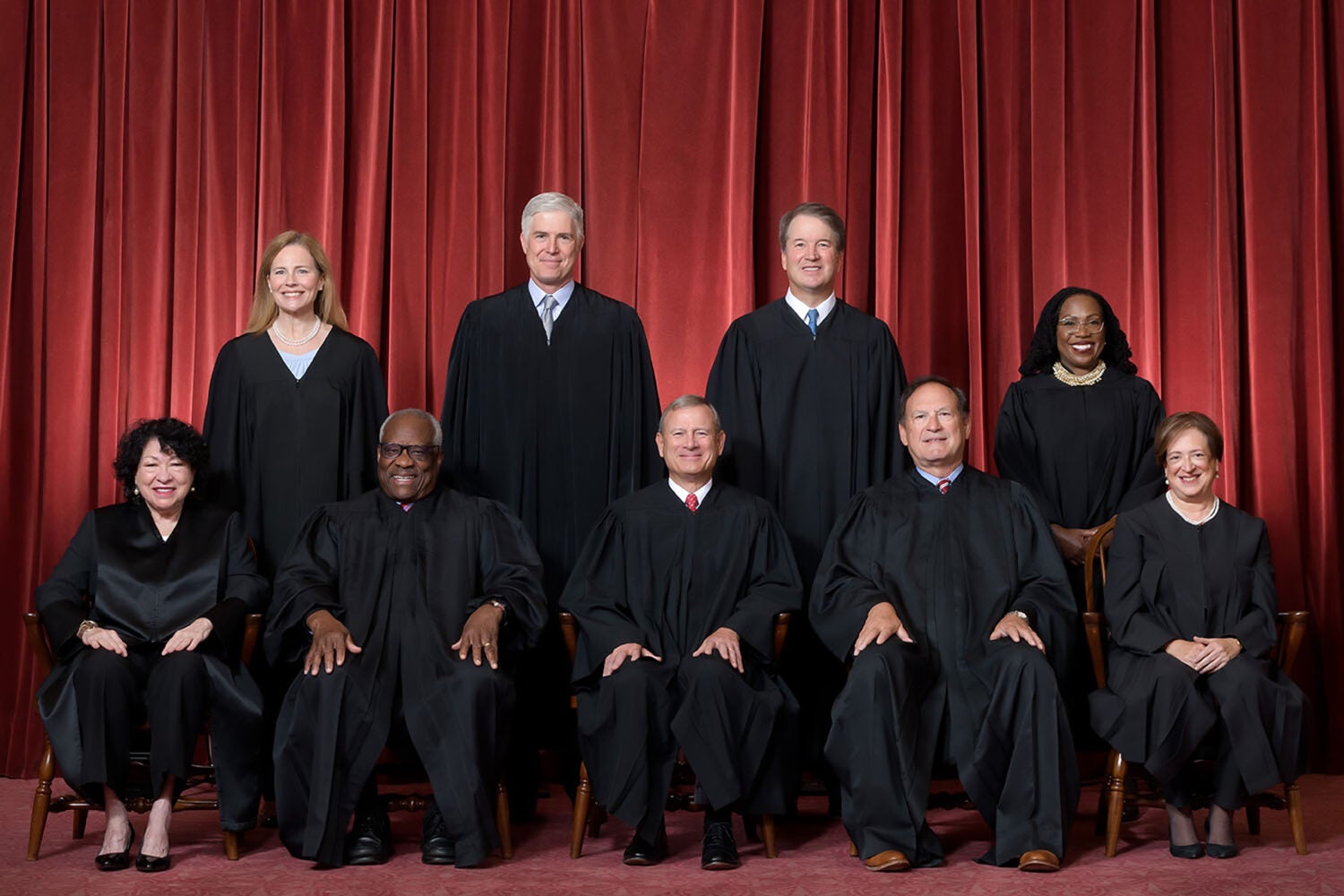The recent trajectory of the Roberts Court has “really changed my teaching over the last two years,” said Columbia Law School Professor Olatunde Johnson at a virtual event hosted by Harvard Law School last week.
Johnson spoke during a discussion called “Teaching the Roberts Court: Challenges, Opportunities, and Strategies,” which was moderated by Jeannie Suk Gersen ’02, the John H. Watson, Jr. Professor of Law at Harvard. The latest installment in the Harvard Law series examining the Supreme Court’s role in a constitutional democracy focused on how teaching about the Court has — or should — change in response to recent decisions that have altered fundamental understandings of law and constitutional rights.
For Johnson, moves by the Court to overturn precedent or bring in new interpretive tools such as the “major questions doctrine” has made her reflect on her pedagogical approach. “The reason it has made me really think about my teaching differently is, in part, because of the challenges posed by students themselves,” she said. “I think they see the Court in a different light. They’re less venerative of the Supreme Court as an institution. They come in with more skepticism and questions.”
“The reason it has made me really think about my teaching differently is, in part, because of the challenges posed by students themselves.”
Olatunde Johnson, Columbia Law School Professor
Professor Michele Bratcher Goodwin of UC Irvine Law said she was interested in considering the Roberts Court’s “firmer turn towards originalism.” An expert in reproductive rights, Goodwin questioned the tendency by some advocates to reject originalism or history outright.
Look at the Reconstruction Amendments passed after the Civil War, said Goodwin, who is also the Abraham Pinanski Visiting Professor of Law at Harvard. “Central to the debates” about the 13th and 14th Amendments, Goodwin continued, was “the sexual subordination and involuntary reproductive servitude of Black girls and Black women.” She added that proof in the form of written speeches and other documents “are very easy to find but have been overlooked both by those who take a progressive view of the Constitution, and also those who have articulated a conservative view of the Constitution.”

Gersen then turned to Margaret H. Lemos, a professor at Duke Law, who, she noted, has written a casebook about judicial politics and teaches a course on judicial decision-making. “What can we learn when we teach about the Court?” Gersen asked.
“The book and the course are both efforts to study, and get our students to study, courts as institutions, in the same way that we might study Congress as an institution,” says Lemos. She added that her book and course also examine other factors — beyond legal doctrine — that can have an impact on courts’ decisions, including ideology, patterns of litigation, public opinion, and politics. “I think one of the things we think is important is to try to convey to students the importance of seeing the U.S. Supreme Court, and all courts, as part of a larger legal and political ecosystem and not just in isolation.”
These discussions are important, said Lemos, because the way professors teach about the Supreme Court and the courts in general may influence their students’ views of how the system works or does not.
“My students … do not need much help in rejecting a formalistic or mechanical understanding of the law — that judges are just calling balls and strikes,” she said. “But many of them I think jump too far from that to the other end of the spectrum, and to what is an equally simplistic and caricatured view in which the law is nothing but a post hoc rationalization for a decision that was reached entirely on other grounds.”
Randy Barnett ’77, a professor at Georgetown Law, agreed with the importance of putting legal doctrine into a broader context while teaching about the Supreme Court. “The best way I have found to teach it is to teach the development of constitutional law not as a series of set doctrines, but as a constitutional narrative that begins at the founding and works its way to the present,” he said.
Pointing to the fact that five justices of the Supreme Court now identify as originalists, “I think that puts a burden on law professors to teach what originalism is in a sensitive and sophisticated manner,” he said. Armed with an understanding of originalism, he said, “one of the things that you will realize is that we don’t actually have an originalist Court,” as in “five justices who are committed to following the original meaning of the text over and above other considerations that they may wish to follow.”
Professors do students a disservice by dismissing the subject, said Barnett. “The only way to critique the Court on its own terms is to understand what that term, ‘originalism,’ means and what it does.”
Robert S. Chang, who is the executive director of the Fred T. Korematsu Center for Law and Equality and a professor at Seattle University School of Law, had a slightly different perspective. Law schools, he said, may be placing too much emphasis on teaching federal courts and the Supreme Court in lieu of state courts and state constitutionalism. In fact, he said, state courts may be the key to advancing rights.
“I have not given up on the federal courts, not in any in any manner,” he added. “But I do think … we really need to do more with regards to state constitutional litigation.”
““I have not given up on the federal courts, not in any in any manner. But I do think … we really need to do more with regards to state constitutional litigation.”
Robert S. Chang, executive director of the Fred T. Korematsu Center for Law and Equality and a professor at Seattle University School of Law
Chang highlighted some of the work he and his colleagues at the Korematsu Center are doing in Washington State to combat racial discrimination in the criminal legal system, including their success arguing to the Washington Supreme Court about implicit bias — arguments that he said other states are starting to pay attention to as well.
“In some ways, I think in legal academia, we have the matrix, right: that’s the federal system,” he said. “And we have the minor leagues, and that’s the state system. And I really think that we need to get past that, because we do a disservice to our students if we don’t.”
Summarizing the participants’ points, Gersen noted that each panelist “detailed things that you teach that are not completely discontinuous with the approach that you may have favored before the Roberts Court, as in, by no means is it a sudden development that you’ve been teaching this way,” she said. “But that [approach] involves things like context, whether its history, method, originalism, for example; whether it’s institutions, and design and reform of the courts. Or thinking about the place of the Court in a constitutional democracy, the importance of the larger ecosystem, and understanding how the Court fits into that larger ecosystem. And the role of state courts and how they interact with the federal system.”
Given that many of the panelists were already incorporating these things into their lessons, what opportunities might the Roberts Court present to deepen their teaching, wondered Gersen.
“Something about the combination of the confirmation battles and Dobbs [v. Jackson Women’s Health] raised a new set of questions,” Johnson responded. “They made people more open to thinking about questions around the legitimacy of the Court — which I don’t use lightly as a term … and started to think about questions [like] ‘Why is our Constitution so hard to amend? Why do we have lifetime tenure for our judiciary?’ The questions just became more fundamental.”
Goodwin concurred, adding that ideological differences are nothing new for the Court. “But we’ve seen now the expression of our democracy and its own vulnerability in a way in which perhaps we have not seen in decades,” she said. “And I think that further adds to the point about being more thoughtful, more nuanced about what we teach, and also making sure that we provide the materials available to students such that they can think in substantive, rigorous ways about what it is that we’re trying to express. Sometimes the cases alone can’t do that work.”
Want to stay up to date with Harvard Law Today? Sign up for our weekly newsletter.
